Weekly Advanced Technologies〔62〕

Weekly Advanced Technologies〔62〕| Sow and Harvest "Mini-version of Human Organs": Innovative Therapies Speed up Tissue Repair of Frostbite Wounds | "Reproduce" Cosmic Shock Waves in the Laboratory, with Lasers "Uncovering" the Secrets of Supernovae
Never underestimate the laboratories of scientists. Although it is a small place, there is a great deal inside. Every little spark in the experiment may shine on a novel scientific field. In this seemingly unremarkable space, there are limitless possibilities for exploring the mysteries of the universe and unlocking the secrets of nature and life.
The team led by LENG Ling from the Institute of Clinical Medicine, Peking Union Medical College Hospital, has developed a "drug" that can significantly accelerate wound healing and reduce early-stage inflammation after frostbite in response to the clinical difficulty of how to accelerate the healing of frostbite wounds. Notably, this "drug" is made up of skin organoids derived from human-induced pluripotent stem cells "grown" in the laboratory combined with hydrogel.
Relying on the high-power laser "Shenguang III (SG III) prototype" device in Mianyang, Sichuan Province, the joint research team composed of the Research Center of Laser Fusion of the China Academy of Engineering Physics, the Department of Astronomy in the School of Physical Science and Technology of Xiamen University, and the Institute of Applied Physics and Computational Mathematics has created shock waves in the laboratory and quantitatively demonstrated for the first time the feasibility of studying the propagation of radiative shock waves in core - collapse supernovae in the laboratory.
Based on the weekly diary of technology provided by the daily list of the NCSTI online service platform, we launch the column "Weekly Advanced Technologies" at the hotlist of sci-tech innovation. Today, let's check out No.62.
1. Protein & Cell丨Sow and Harvest "Mini-version of Human Organs": Innovative Therapies Speed up Tissue Repair of Frostbite Wounds
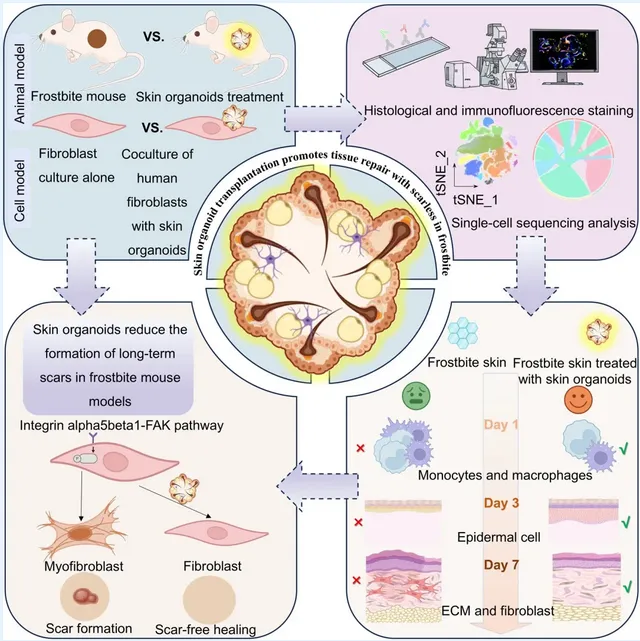
Skin organoid transplantation promotes tissue repair with scarless in frostbite wounds
Frostbite wounds that fail to heal for an extended period will not only result in scar formation but may also necessitate amputation in severe cases and even lead to malignant tumors. Consequently, accelerating the healing of frostbite wounds remains a clinical challenge. The team led by LENG Ling at the Institute of Clinical Medicine in Peking Union Medical College Hospital has developed a "drug" which can significantly accelerate wound healing and reduce early-stage inflammation after frostbite. This drug is constructed by combining skin-like organoids derived from human-induced pluripotent stem cells with a hydrogel.
The injury caused by cold exposure is known as frostbite, and frostbite is a common emergency during the cold season for those working in low-temperature environments. At present, the commonly-used treatment is still mainly based on the traditional use of ointment. Since frostbite is more complex and more difficult to heal than ordinary skin injuries, prevention, early diagnosis, and active treatment are of great importance.
With the development of the stem cell research field, organoid research is also constantly advancing. Briefly, the formation process of organoids is like "growing" a mini - version of a human organ in the laboratory. The main steps include preparing the "seed", the "soil", and the "fertilizer". Once everything is ready, sowing and cultivation are carried out. The "seed" refers to stem cells; the "soil" means an environment suitable for the growth and differentiation of stem cells, usually including a 3D scaffold (such as Matrigel, etc.); the "fertilizer" is the growth factor that promotes the growth and differentiation of stem cells. The prepared stem cells are "sown" onto the 3D scaffold. These stem cells will start to grow and self-assemble on the scaffold. Researchers add various growth factors to simulate the environment of cell growth in the body. Then the stem cells start to differentiate, form different types of cells, and are arranged according to a specific spatial structure. Eventually, a "mini-version" of a functional simulated organ-the organoid-is formed.
The research team used human-induced pluripotent stem cells to culture a full - layer skin - like organoid with epidermal and hair follicle appendages, dermis and fat, as well as the nervous system for the targeted treatment of second-degree frostbite. Their study revealed that the transplantation of skin-like organoids significantly accelerated the wound healing of frostbitten skin. Pathological analyses indicated a significant improvement in inflammation and vascular damage, and the transplantation of skin organoids promoted the rapid recovery of collagen expression in skin tissues affected by frostbite.
The investigators also found that the proportion of immune cells, including monocytes, macrophages, and Langerhans cells, was reduced in skin tissues that had received skin organoid transplants for 1 day compared with untreated skin tissues, suggesting that organoid therapy can modulate the excessive inflammatory response due to recurrent activation of inflammatory cells in the injured tissues, thereby inhibiting the formation of frostbite scarring.
2. Science Bulletin丨"Reproduce" Cosmic Shock Waves in the Laboratory, with Lasers "Uncovering" the Secrets of Supernovae

Schematic of radiative shock waves in a core-collapse supernova; spatial distribution of temperature and density of radiative shock waves obtained in the laboratory
Relying on the high-power laser "Shenguang III (SG III) prototype" device in Mianyang, the joint research team composed of the Research Center of Laser Fusion of the China Academy of Engineering Physics, the Department of Astronomy in the School of Physical Science and Technology of Xiamen University, and the Institute of Applied Physics and Computational Mathematics has created shock waves in the laboratory and quantitatively demonstrated for the first time the feasibility of studying the propagation of radiative shock waves in core-collapse supernovae in the laboratory.
Radiative shock waves generally exist in celestial explosion phenomena. For core-collapse supernovae, due to the fact that direct astronomical observations of the explosion process are difficult to obtain because of radiation self-absorption and the driving mechanism of core-collapse supernovae is still unclear, etc., it is necessary to create shock waves in the laboratory and study their propagation, and provide parameter calibration for the numerical simulation of core-collapse supernovae through controllable and quantitative operations.
The research team has driven shock waves in xenon gas of 1.2 and 1.9 atm with laser energies ranging from 1600 to 2800 J on a high-power laser “Shenguang III (SGIII) prototype” device in Mianyang, Sichuan Province. The average velocity of the shock wave was obtained by using a backlit photographic image, and the post-wave compression density was obtained for the first time by data processing, which was in good agreement with the velocity and compression density obtained by simulation with a two-dimensional radiation-fluid program.
The team further combined the simulated temperatures with the shrinkage calibration rate to conduct a comprehensive comparison with the radiative shockwave states in the core-collapse supernova simulation, and the results are in perfect agreement. This work represents the first quantitative demonstration of the feasibility of laboratory studies on radiative shock wave propagation in core-collapse supernovae. It also lays the foundation for subsequent analysis of the time-series evolution of the outbursts, the revelation and quantification of the energy dissipation mechanism of the shock waves, and the examination of the mechanism of the outbursts of core-collapse supernovae.
3. Materials Today丨Scientists' Cross-border Cooperation to Explore the "Optimal Solution" in the Inverse Design of Phononic Metamaterials
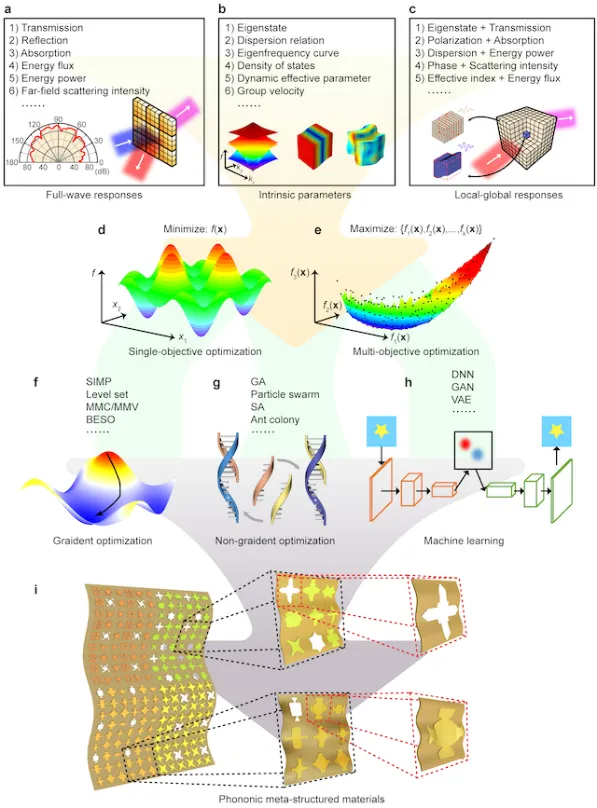
An overview of the reverse design methodology for phononic superstructured materials
Phononic meta-structured materials (PMSMs) are a type of artificial microstructured materials. Through the design of microstructured functional elements, the propagation of acoustic/elastic waves in these materials can be controlled to achieve novel wave-related properties. PMSMs include phononic crystals, traditional subwavelength acoustic metamaterials, and hypersurfaces.
Over the past three decades, phononic metamaterials have drawn extensive attention. They have demonstrated astonishing capabilities in manipulating elastic or acoustic waves for a great number of complex wave-related phenomena and functions, ranging from dispersion engineering, wavefront modulation, to even the arbitrary construction of the entire wavefield.
One of the central issues regarding phononic meta-structured materials is how to rationally design structures at different scales/levels to achieve the desired structure-wave interactions. The traditional design of phononic meta-structured materials mainly depends on intuition or experience, and it often encounters problems such as a limited design space, restricted wave-related properties or functions, and a lack of systematicness.
In response to this, many scientists, including DONG Haowen from the Institute of Advanced Structure Technology, Beijing Institute of Technology, WANG Yuesheng from Tianjin University, SHEN Chen from Rowan University, CEHNG Li from The Hong Kong Polytechnic University, and Steven A. Cummer from Duke University, have cooperated to jointly publish a cutting-edge review article. This article systematically reviews the research progress in the field of inverse design of phononic metamaterials, comprehensively sorts out the basic concepts, connotations, inverse-design methodologies of phononic metamaterials, phononic metamaterials designed by inverse methods and customized wave-related functions, as well as typical applications of customized phononic metamaterials, and looks forward to the future research on the inverse design of phononic metamaterials.
4. The Breakthrough of the Brain-Spinal Cord Interface: Bringing Hope of Re-walking to Spinal Cord Injury Patients
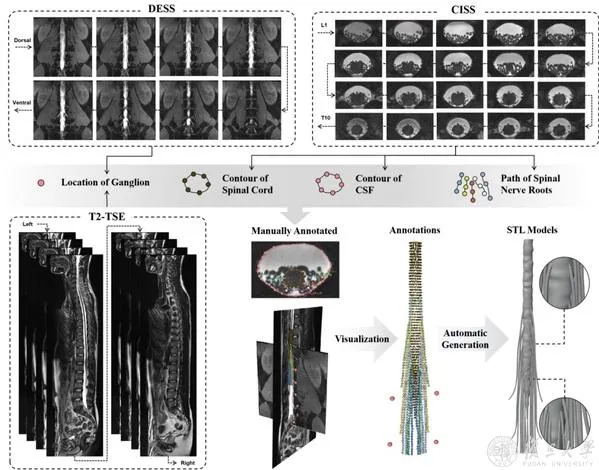
3D model of spinal nerve root image reconstruction
As the "high-speed information channel" linking the brain and the peripheral nervous system, damage to the spinal cord prevents instructions from the brain from reaching the muscles, causing patients to lose their ability to move independently. Restoring the motor abilities of paralyzed patients with spinal cord injuries has long been a significant challenge in the medical field. According to the "China Spinal Cord Injury Quality of Life and Disease Burden Research Report 2023", there are 3.74 million spinal cord injury patients in China, with approximately 90,000 new cases annually. If paralyzed patients can regain the ability to stand, it would represent a groundbreaking leap from 0 to 1.
The JIA Fumin's team in the Institute of Science and Technology for Brain-Inspired Intelligence at Fudan University has developed a new-generation implantable cerebro-spinal interface device for spinal cord injury patients. This project has won the Excellence Award in the 2024 National Disruptive Technology Innovation Competition, and the first clinical trial is expected to be carried out by the end of the year.
How can the spinal nerve roots be accurately stimulated and the corresponding muscle groups in the lower limbs be alternately activated to reconstruct the walking gait? Gafumin's team, by using the 3T magnetic resonance imaging equipment at the Zhangjiang Brain Imaging Center, innovatively designed an imaging scheme that encompasses multiple scanning sequences. They also constructed an automated reconstruction algorithm model based on artificial tags to precisely capture the structural characteristics of the lumbosacral spinal cord nerve roots. Recently, the relevant data and the generated individualized spinal cord nerve root model have been made open - source, providing support for experts in the field of neurorehabilitation to conduct basic research on spinal cord neuromodulation.
The Jia Fumin's team adopts multi-modal technologies such as infrared motion capture, electromyography, inertial sensors, and plantar pressure pads to construct datasets of healthy gaits and various abnormal gaits, and establish algorithm models, achieving high-performance tracking of continuous gait trajectories across populations, modalities, and types, which lays the foundation for cerebro-spinal interface technology.
They propose a "three-in-one" system design plan, integrating three devices into one mini - device for cranial implantation. This not only reduces the postoperative wound of patients but also enables the integration of collection and stimulation, achieving closed-loop regulation of patients' autonomous movements.
This plan can transfer the decoding process from outside the body to inside the body, improving the stability and efficiency of EEG signal collection, and ultimately achieving a decoding speed and stimulation instruction output at the level of 100 milliseconds. The reaction time of normal people is about 200 milliseconds, which means that in the future, the walking gait of spinal cord injury patients will be more natural and smooth.
5. SCIENCE CHINA Information Sciences Explore the New Potential of High-Frequency Applications of Two-Dimensional ReSe2 Semiconductor
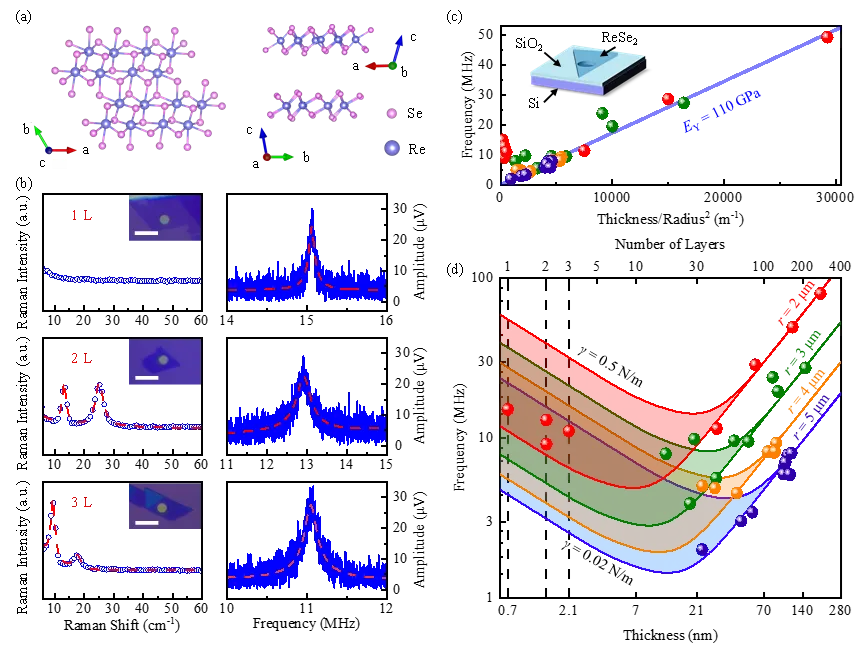
The crystal structure of ReSe2, nano-electromechanical devices based on 1-to 3-layer ReSe2 materials, the frequency design rules for such devices, and the extraction of Young's modulus of two-dimensional ReSe2 crystals
Two-dimensional (2D) semiconductors are semiconductor materials with material thicknesses on the nanometer scale (usually less than 100 nanometers). These materials process unique physical and chemical properties, such as quantum size effect, surface effect and quantum tunneling effect, etc. These properties make 2D semiconductors have a significant advantage in the construction of new nano-devices, of which ReSe2 (rhenium diselenide) is a typical representative, and has made a series of progress in two-dimensional lasers, transistors, and photodetectors, and other important areas of application.
Scientists from the University of Electronic Science and Technology (UEST), namely WANG Zenghui, XIA Juan, ZHU Jiankai, and XU Bo, worked together on this study. They prepared over 30 circular ReSe2 drum resonances, ranging from monolayers to over a hundred layers, through the dry transfer technique. The devices operated within the high-frequency to ultra-high-frequency range. After further summarizing and analyzing the experimental data of the device resonances, the researchers successfully determined that the Young's modulus of the two-dimensional ReSe2 crystals is 110 GPa and established the frequency design rule for ReSe2 nanoelectromechanical devices. These results are anticipated to offer crucial guidance for the design of new ReSe2 nanodevices and their applications, and to promote the development of 2D ReSe2 nanoelectromechanical devices.
6. Science Advances丨Uncovered by MRI Data of 7,000 People! New Discoveries Regarding Brain Structural Characteristics in Neurodegenerative Diseases
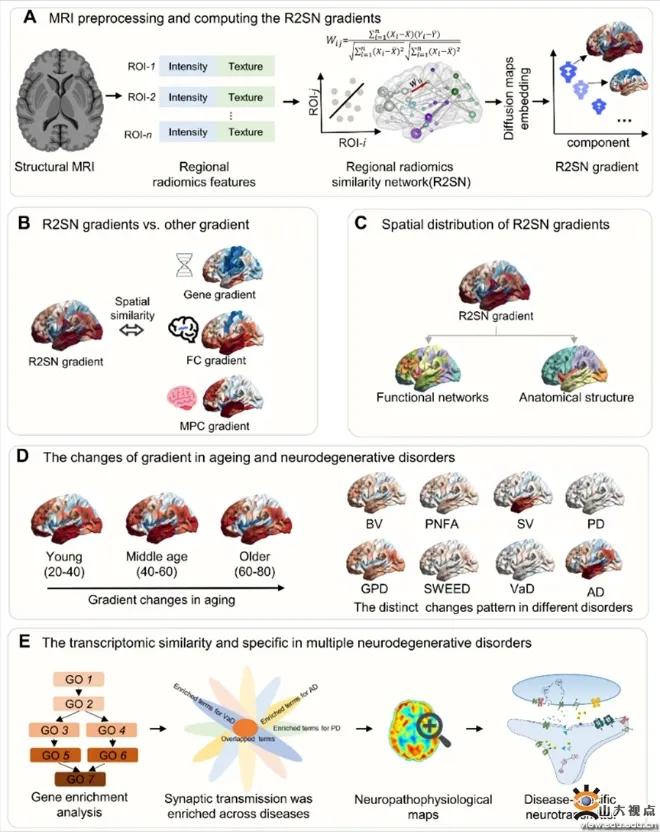
Neurodegenerative diseases (or processes) such as normal aging, Alzheimer's disease (AD) and frontotemporal dementia (FTD) have overlapping brain structural manifestations, but they each have typically distinct clinical manifestations. Recently, Qilu Hospital of Shandong University has cooperated with Beijing University of Posts and Telecommunications and united with many domestic hospitals to reveal the brain structural characteristics of normal aging and various neurodegenerative diseases, attempting to answer a series of important questions such as "What are the brain-structure-specific manifestations among different diseases (states)?" and "What microscopic factors lead to the complex clinical phenotypes of different diseases (states)?".
By incorporating over 7,000 cases of magnetic resonance imaging (MRI) from multicenter and cross-disease datasets, the research team developed a new brain-structure computational method capable of characterizing brain structural abnormalities. Moreover, they further systematically explored the patterns of brain structural abnormalities across different diseases based on cross-disease and multi-omics data. They discovered that aging is associated with widely distributed yet mild brain structural changes, whereas AD shows typical regional damage, such as in the default networks and subcortical nuclei, indicating that complex brain-network structures can better capture disease-specific characteristics.
Their research further explored the potential biological mechanisms behind the brain-structure-abnormal patterns in different diseases. The results showed that aging is mainly related to changes in ion transport, while different types of dementia are related to abnormal chemical neurotransmitters, revealing the differences in the biological processes between dementia and aging. In addition, the research also revealed the specificities among different types of dementia. For example, AD is mainly related to the serotonin system, and Parkinson's disease (PD) is mainly related to the dopamine system, which provides a biological basis for the specific clinical phenotypes of different types of dementia and also potential intervention targets for different diseases.
Columnist: Li Xiaoxiao
Translator: Liu Kaiyuan